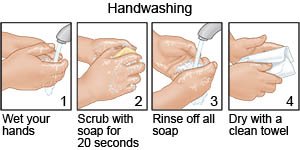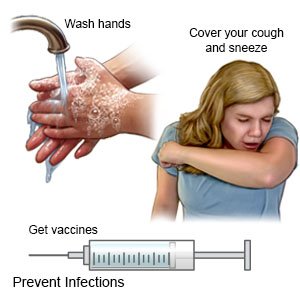Parainfluenza
Medically reviewed by Drugs.com. Last updated on May 6, 2024.
What is parainfluenza?
Parainfluenza is a very contagious type of viral respiratory infection. It is caused by any of the 4 kinds of human parainfluenza viruses. These viruses can cause croup, bronchitis, bronchiolitis, ear infections, or pneumonia in adults and children. Parainfluenza is easily spread when an infected person coughs, sneezes, or has close contact with others. Anyone can get a parainfluenza infection, but they are more common in infants and young children.
What are the signs and symptoms of parainfluenza?
- Fever
- A regular cough or a rough, barking cough
- Runny or stuffy nose
- Sore throat, sneezing, or ear pain
- Hoarseness, wheezing, or rapid, noisy, or labored breathing
- Drooling or trouble swallowing
- Irritability, decreased appetite, or diarrhea
How is parainfluenza diagnosed?
Your healthcare provider will ask about your symptoms and examine you. Tell him or her if you have been around sick people or traveled recently. You may need any of the following:
- A nose and throat swab may be done to test for parainfluenza. You may get the results in minutes or the swab may be sent to a lab for more tests.
- Blood tests may show the infection and which virus is causing your symptoms.
How is parainfluenza treated?
No specific treatment is available for a parainfluenza infection. You may need any of the following to relieve your symptoms:
- Acetaminophen decreases pain and fever. It is available without a doctor's order. Ask how much to take and how often to take it. Follow directions. Read the labels of all other medicines you are using to see if they also contain acetaminophen, or ask your doctor or pharmacist. Acetaminophen can cause liver damage if not taken correctly.
- NSAIDs , such as ibuprofen, help decrease swelling, pain, and fever. This medicine is available with or without a doctor's order. NSAIDs can cause stomach bleeding or kidney problems in certain people. If you take blood thinner medicine, always ask your healthcare provider if NSAIDs are safe for you. Always read the medicine label and follow directions.
- Antivirals help fight a viral infection.
How can I manage my symptoms?
- Rest as much as you can to help you recover.
- Use a cool mist humidifier to increase air moisture in your home. This may make it easier for you to breathe and help decrease your cough. A few minutes outside in the cool night air may help your breathing. Sitting in a bathroom filled with steam from a hot shower may also be helpful.
- Drink liquids as directed to help prevent dehydration. Ask how much liquid to drink each day and which liquids are best for you.
How can I help prevent parainfluenza?
- Wash your hands often. Use soap and water every time you wash your hands. Rub your soapy hands together, lacing your fingers. Use the fingers of one hand to scrub under the nails of the other hand. Wash for at least 20 seconds. Rinse with warm, running water for several seconds. Then dry your hands with a clean towel or paper towel. Use germ-killing hand sanitizer if soap and water are not available. Do not touch your eyes, nose, or mouth without washing your hands first.

- Cover a sneeze or cough. Use a tissue that covers your mouth and nose. Throw the tissue away in a trash can right away. Use the bend of your arm if a tissue is not available. Wash your hands well with soap and water or use a hand sanitizer. Do not stand close to anyone who is sneezing or coughing.
- Clean shared items with a germ-killing cleaner. Clean table surfaces, doorknobs, and light switches. Do not share towels, silverware, and dishes with people who are sick. Wash bed sheets, towels, silverware, and dishes with soap and water.
- Wear a mask over your mouth and nose if you are sick. The face mask may help protect others from becoming infected. Wear the mask when you are in common areas of your home or if you seek care from a healthcare provider.
- Stay away from others if you are sick. Stay at home until 24 hours after your fever and symptoms are gone.
- Ask about the pneumococcal vaccine. Stay up to date on the pneumococcal vaccine. This will decrease your risk for developing pneumonia in addition to the parainfluenza. Ask about any other vaccines you may need.
 |
Call your local emergency number (911 in the US) if:
- You have trouble breathing.
When should I call my doctor?
- Your symptoms get worse or do not get better with medicine.
- You have questions or concerns about your condition or care.
Care Agreement
You have the right to help plan your care. Learn about your health condition and how it may be treated. Discuss treatment options with your healthcare providers to decide what care you want to receive. You always have the right to refuse treatment. The above information is an educational aid only. It is not intended as medical advice for individual conditions or treatments. Talk to your doctor, nurse or pharmacist before following any medical regimen to see if it is safe and effective for you.© Copyright Merative 2024 Information is for End User's use only and may not be sold, redistributed or otherwise used for commercial purposes.
Further information
Always consult your healthcare provider to ensure the information displayed on this page applies to your personal circumstances.
